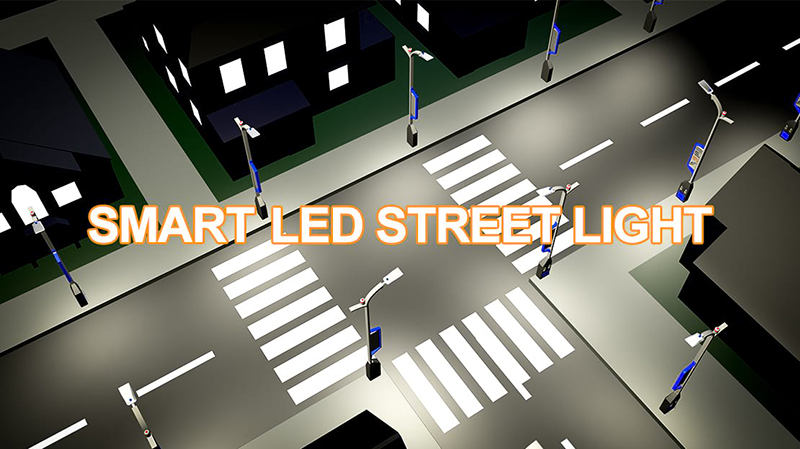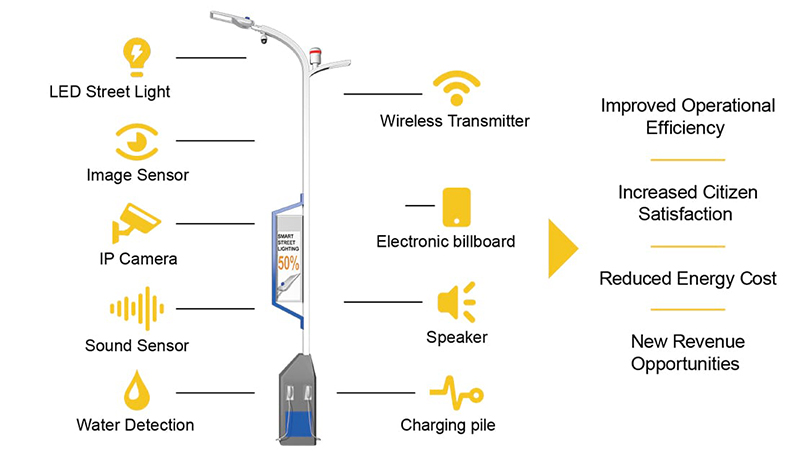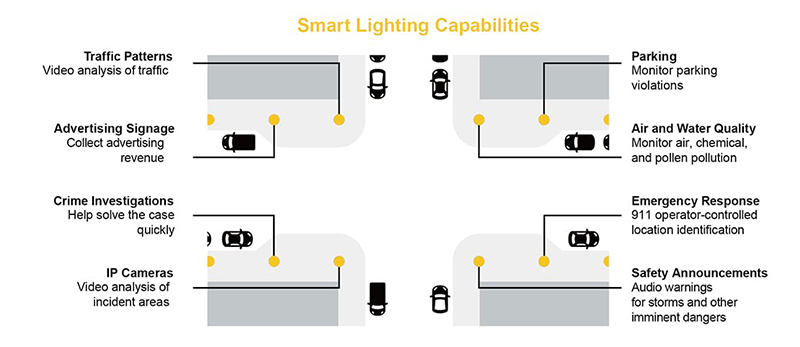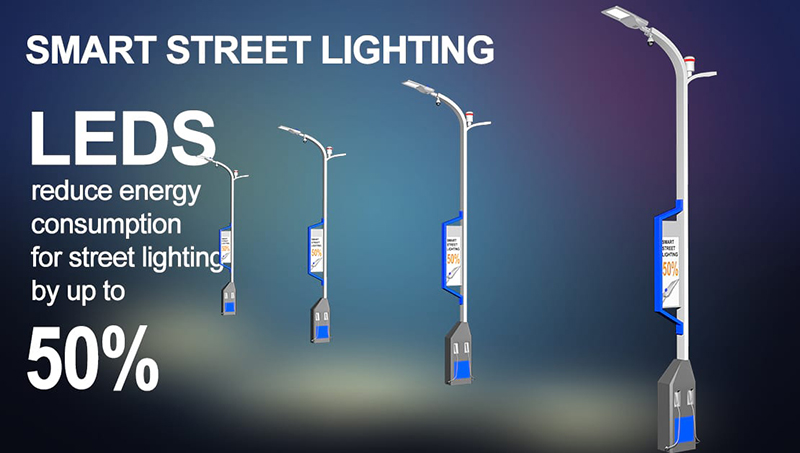Table of Contents +
Smart street lights provide more than just lighting,Provided extended services for lighting, reduced costs and new revenue opportunities

With the rapid development of technology in cities around the world, they have turned their attention to smart digital infrastructure.
In the past, simple buildings, roads and bridge systems have now become an integrated and interconnected network of physical and online services when moving "online", and this transformation is how we light up cities.
Smart street lights can change the way municipalities manage cities while saving a lot of costs. Street lighting accounts for nearly 40% of total energy costs in many cities, and local governments and utility providers are looking for new ways to reduce energy use and lower costs. Switch from halogen to
By reducing energy consumption, LED illuminators can immediately save 50% to 80% of the cost, thereby helping to achieve this goal.
In addition, installing smart LEDs can save 10% to 20% of the cost by adjusting the output to ambient light level, dimming or brightening as needed. You can also set them to detect motion only when they are, and then dim or turn off after a certain time. In addition to saving money, the city has also gained enhanced features and functions. By using existing brackets and utility poles, cities and utility providers can cost-effectively add a variety of devices and sensors.
Smart street lights can help monitor traffic flow, parking, crosswalks, seismic activity, or atmospheric changes. They can be equipped with speakers to alert people to dangerous situations or conditions, or with cameras to help police solve crimes or verify garbage collection and other activities. With these functions, cities can improve operational efficiency, increase citizen satisfaction and reduce costs. In addition, smart street lights can also bring new revenue opportunities, such as digital signage and other service rental poles.

• Improve citizen satisfaction. Smart street lights contribute to safety by helping to improve livable cities and reduce traffic congestion.
• Reduce energy costs. Smart street lights manage electricity more effectively, leading to higher costs and saving costs compared to simple LED lamps.
• Increase income opportunities. Smart street lights can digitally provide new revenue opportunity signage and other functions.
Smart street lights provide multiple functions that can benefit cities, utility providers and citizens. Understanding these benefits helps determine the best solution. But deciding what is difficult to implement due to today’s challenges:
•technology. There are platforms with multiple applications and technologies to choose from, and it may be difficult to identify which ones meet specific needs. There is also a lack of universal standards across networks, and choosing one may have currently unknown future effects.
•safety. Transfer data when adding cameras and other functions to understand security and privacy issues before implementation. There are many options that provide security, control, and management, but these are also frequently used and may have future implications.
•ownership. Street lights are owned and maintained by different entities in different locations. It may be responsible for issues related to how to modify street lights, such as dimming and turning off without adequate testing.
•cost. In many cases, street lights are expensive budget items that account for 50% of the city's total energy costs. And as cities expand, these costs are also increasing in size and population globally. Switching from halogen to basic LED lamps can save up to 80% immediately.
• Regulations. Resource availability and climate issues, such as carbon emissions, are leading to government changes that must be considered.
Switching to smart LED lights can save an additional 10 and save more than 20% of the cost. Switch to LED because smart lights can be turned on and off more by introducing ambient light into the account. But switch to smart street lights.
A series of sensor-based functions that can be used in smart street lights can solve many problems, improve lives, and even provide new sources of income.
•Traffic control. Video surveillance can help cities better understand traffic and pedestrian patterns, make adjustments, and arrange emergency vehicles near crowded areas.
• Parking control. Street light sensors can provide information about available parking in densely populated areas, and can monitor whether vehicles violate parking regulations without sending people to the streets.
• Detection and prevention of crime. Street lights with cameras can help the police solve crimes after they happen.

And prevent new crimes from happening. With the help of sound sensors, the police can pinpoint specific information such as shootings, and then quickly protect the area.
• Emergency response: Emergency response operators can activate street lights to help guide emergency personnel to specific locations. The indicator lights can also flash sequentially, or the color can be changed to indicate emergency evacuation routes during natural disasters such as floods and tornadoes.
• Environmental monitoring. Street lights can be equipped with sensors that identify toxic chemicals, pollen counts, or air pollution levels. According to the World Health Organization, air pollution is the biggest single environmental health risk.
• Warnings and alarms. A lamp equipped with a speaker can be used to warn people in the vicinity of a storm or other impending danger.
• Public kiosks. Street lights can be used as public auxiliary equipment to provide guidance for regional shopping or public transportation schedules.
•advertising. A city leased its poles to a company that equipped it with digital signage and smart units to collect advertising and subscriber revenue.
In the street lights of every community in every city in the world, the opportunity to convert a simple light into a tool that can improve the livability of the area is not just a benefit; it improves citizen satisfaction and safety.
By converting to smart LED street lights, cities can save costs immediately. LEDs consume much less energy, and smart lights optimize their efficiency by recognizing environmental conditions and adjusting energy consumption accordingly.
Smart street lights can surpass basic lighting functions and become a source of new income. Cities can rent out various functions (such as digital advertising or Wi-Fi* hotspots) to various companies and organizations. Savings and income opportunities include:
• Reduce energy costs. Compared with simple LED lamps, smart lighting with optimized dimming, on/off programming or action activation can save more costs.
• Optimized maintenance. For municipalities and public utilities, street lights are expensive to maintain, and elevator equipment is required in many places. Maintenance personnel usually have to interrupt traffic or stop to access the lights. With the help of smart street lights, cities can use the collected data to predict lamp failures, such as the hours of lamp operation and the status of the lamps. Motion sensors and cameras can also provide information about the best time to schedule maintenance.
• Increase income opportunities. With add-ons such as digital signage, Wi-Fi hotspots, and other features, entities can increase revenue opportunities. In essence, street lights and telephone poles are becoming more and more like self-financing real estate.
• Use existing infrastructure. Smart street lights can be installed on existing telephone poles, saving money is as simple as replacing lights, and without new investment in infrastructure, services in the old city can become the backbone.
• Edge analysis. For example, real-time information can remind emergency personnel to respond faster. IP cameras can stream images when an incident occurs, reducing the need for manual inspections afterwards. With certain solutions, edge analysis can detect anomalies and only transmit relevant information to speed up response and reduce costs.
• Improve citizen satisfaction. Through improved traffic flow, safer crosswalks, environmental monitoring and weather warnings and other solutions, the livability of the city has been greatly improved and citizens are safer and happier. Whether it is a city or a utility provider (regardless of which entity owns a physical pole), they are in a unique position and can add value through additional smart street light functions.

The transition from halogen to simple LED is simple. Smart street lights do not require new infrastructure. Using the same pole and bracket, new lamps can be used to install quickly. Smart street lighting solutions built with smart accessory technology are designed to improve performance and end-to-end security. But one size is not suitable for all sizes, and organizations should consider three solution categories.
•it is good. The basic smart lighting of the smart accessory processor includes light control and basic sensors. This solution can provide additional functions such as basic weather monitoring, environmental monitoring and gunshot triangulation.
•better. The intelligent accessory processor enhances the intelligent lighting including IP camera functions (support 1080p, no edge processing is required), and can pass environmental monitoring, intelligent parking and emergency response applications.
• Best. Smart lighting equipped with a smart accessory processor can include high-end Internet cameras for video (full 4K edge processing), Wi-Fi hotspots, environmental monitoring, smart parking, traffic management, and digital signage applications.
Smart lighting is changing the way cities and utility providers view street lights. Converting to smart street lights can save energy and cost more than simple LEDs. With smart street lights, however, cities can achieve huge benefits. They can increase citizens’ satisfaction because they increase security and reduce congestion. They manage electricity by reducing energy costs more effectively. They increase revenue opportunities with features such as digital signage and Wi-Fi hotspots. Cities and utility providers or revenue opportunities seeking immediate cost savings can now evaluate various options to meet actual needs, resulting in a large number of benefits both now and in the future.
Author 2025-06-12
Hishine Group Limited Will Meet Customers In Mexico City.Hishine is thrilled to announce its participation in Expo Eléctrica International 2025, Latin America’s premier trade fair for power and lighti...
Author 2025-05-12
Our recent business trip to Saudi Arabia proved to be a pivotal step in strengthening partnerships and exploring opportunities in the Kingdom’s rapidly growing energy and lighting markets. Below are t...